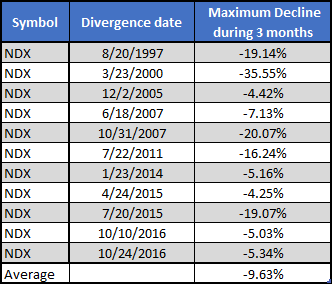In recent weeks, we analyzed signals from the Dow Jones Industrial Average and the Nasdaq 100 to assess overall market health.
On March 6th we said our Dow-based indicators signaled more trouble ahead. But on March 13th we noted that technology looked better than the industrials. We pointed out that while the Dow was looking weak, the Nasdaq was not yet flashing a bright red warning sign.
But we also urged caution in the piece, because the current “divergence” of strength and weakness between the Dow and the Nasdaq had the potential to resolve itself in one of two ways.
Either the Dow could return to bullish strength, being pulled up to follow the Nasdaq… or the Nasdaq could weaken and break down, going into bearish decline mode like the Dow.
Well, as you have probably heard, Facebook had a very bad week this week. It may have been Facebook’s worst week ever as a public company.
Facebook (FB) sold off heavily, losing tens of billions in market value, on fears that Congress may impose harsh new rules on how social media companies make use of customer data.
Twitter (TWTR) and Alphabet (GOOGL) sold off in sympathy, as they could be subjected to the same rules, which would hurt advertising capabilities and thus reduce profits.
Facebook and Google are two of the mighty FANG companies – an acronym that stands for Facebook Amazon Netflix Google. Some refer to it as FANGAM – to include Apple and Microsoft – and some use FAAMGA which leaves Netflix out.
Whether you prefer FANG or FANGAM or FAAMGA (it doesn’t really matter which one), the point is that these stocks are very important to the health of the Nasdaq… and thus the health of the market itself.
Bloomberg recently reported the following statistic, which is slightly alarming:
- “In late 1999, just before the dot-com bubble bust, technology stocks accounted for just more than 29 percent of the S&P 500 index. They are nearly back to that point, now accounting for just more than 25 percent of the S&P 500. But that doesn’t include Amazon.com Inc. or even Netflix Inc., which S&P Dow Jones Indices classify as consumer discretionary stocks. Include Amazon and Netflix, and tech’s share of the S&P 500 total market cap rises to 28.6 percent.”
There are big differences between 2018 and 1999. The tech giants of today are wildly profitable, for one thing (excluding Netflix). But they also have extremely rich valuations – and they make up a dangerously large percentage of the market.
This puts even more emphasis on our “divergence” concern in respect to the Dow and the Nasdaq.
The weakness in Facebook, and the possibility that investors are falling out of love with FANG stocks, increases the odds that the Nasdaq could resolve lower, falling into weakness like the Dow.
We wanted to quantify the impact of divergence under the following conditions:
- When the Nasdaq reached at least a three-year high but the Dow did not
- When Nasdaq-Dow divergence has persisted for at least one year
- When the Nasdaq began a decline from its highest divergence point
Here is the data table:

A few things to note about this data…
First, while the average Nasdaq decline from its divergence highs is 9.63%, there are some embedded extremes. The three-month decline in the year 2000, for example, was 35.55%.
Second, this is only a three-month time window. It is possible for the decline numbers to be worse in a period longer than three months.
Third, out of eleven instances, six were modest and five were more severe. That suggests about a 45% chance (5 out of 11) that the Nasdaq’s drop from this point could be severe.
The odds of severity on that front – a severe Nasdaq decline – are perhaps increased by a few of the other present-day factors: The FANG stocks, while profitable, have been richly overvalued to nosebleed levels. And technology stocks on the whole have, in some sense, been propping up the entire market.
And last but not least, the fear of Silicon Valley seeing harsh restrictions from a furious Congress (and an angry public) is quite real, given the size and scope of Facebook’s data issues. This could hurt profits; the thing Wall Street really cares about.
Our takeaway message from this is simple: Weakness in the Nasdaq is a serious warning sign that should absolutely be heeded.
As we have mentioned in past editorials, the Dow Jones components already reached the double warning sign status of both 40% or more Dow components being stopped out on an SSI trend basis and the Dow itself going into red zone conditions.
If the Nasdaq also reaches that state — with 40% of the Nasdaq 100 components stopped out on an SSI trend basis, or the Nasdaq 100 Index (NDX) itself going into the red zone — batten down the hatches.





